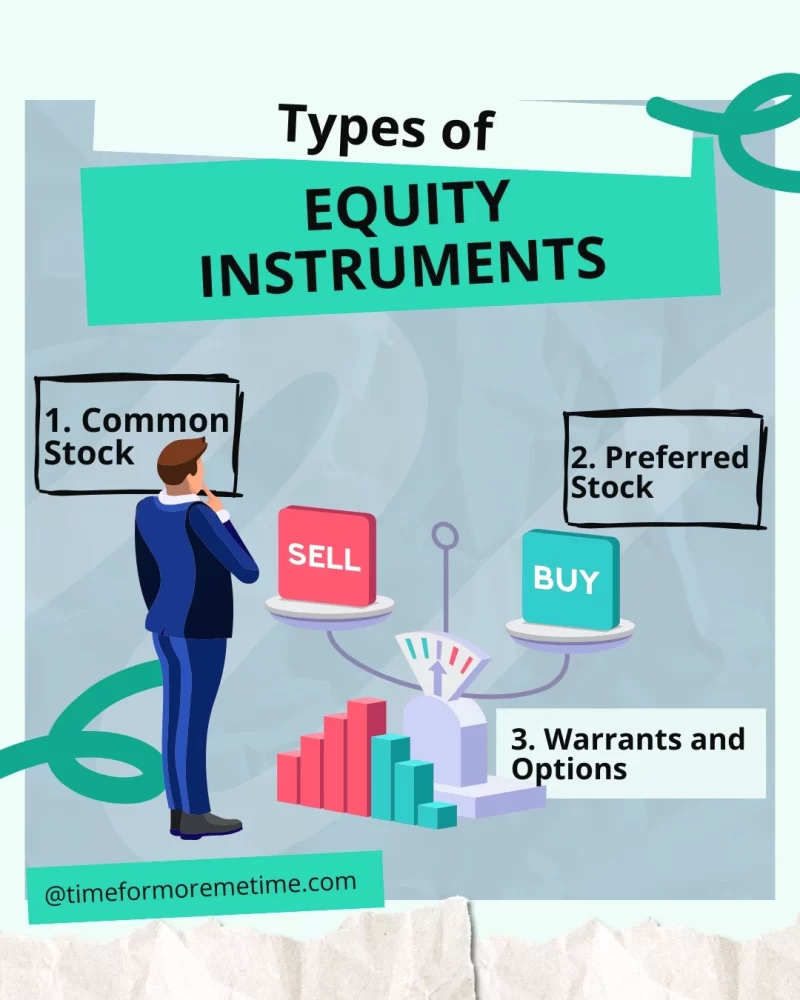Investing can sound confusing when every term feels like a foreign language. If you’ve ever felt stuck trying to understand how you can get into equity instruments, you’re not alone. In this post, I’ll break down equity instruments in plain terms. Let’s get started!
What Are Equity Instruments

Equity instruments are a type of financial asset that represent ownership in a company. When you own an equity instrument, you own a portion of the company that issued it. This ownership can entitle you to a share of the company’s profits and, in some cases, the right to participate in company decisions.
In general, financial assets are non-physical assets that have value and can be traded or sold for money. They can include ownership rights or contractual claims. Specifically, equity instruments are categorized as ownership rights.
Companies issue equity instruments at various stages of their business, most commonly during an initial public offering (IPO). An IPO occurs when a private company decides to go public, allowing its shares or stocks to be purchased by the general public. In addition to IPOs, companies can also issue equity instruments at other times to raise capital or for specific purposes.
Investors buy or invest in equity instruments to profit from companies they believe will grow or become more profitable in the future. With these instruments, there are typically two ways to earn money: dividends and capital gains.
As a part-owner of the company, you may receive a portion of the profits in the form of dividends. Meanwhile, you can sell the stock to others when its price is higher than what you originally paid for it, allowing you to profit from the increase in value.
Here are the main types of equity instruments:
- Common Stock: This is the most common type of equity instrument. It gives you a share of the company’s profits and often includes voting rights on company matters.
- Preferred Stock: This type usually provides fixed dividends and has priority over common stock when the company pays out profits or if it goes out of business.
- Warrants: These give you the right to buy company stock at a set price in the future. They are often used as investment tools or employee incentives.
- Options: These are contracts that give you the right, but not the obligation, to buy or sell a stock at a predetermined price within a specific time frame.
- Hybrid Equity Instruments: These financial instruments combine characteristics of both debt and equity, providing unique investment opportunities. They typically offer features such as fixed income (like interests from debt) along with the potential for ownership benefits (like equity or dividend).
As a new investor, you’ll often start investing in common stock as they’re widely available and easily accessible in brokerages. Investing in common stock can help you learn about market dynamics and develop your investment strategy over time.
Where You Can Invest In Equity Instruments
These days, it’s easier than ever to invest in equity instruments—even if you’re just getting started. Here are the most common ways:
- Stock Markets: These are official places where stocks are bought and sold, like the New York Stock Exchange (NYSE) and the Nasdaq. You can’t buy directly from them, but you access them through a broker.
- Online Brokerages: Websites and mobile apps of online brokerages allow you to open an account and start buying or selling stocks. Many of them have no minimum balance and offer free educational tools for beginners.
- Mutual Funds and ETFs: These group together many stocks so you can invest in lots of companies at once. This lowers your risk and saves time because a professional manages the fund for you. They’re great if you want a hands-off option.
- Retirement Accounts: Plans like 401(k)s and IRAs are designed to help you grow your money for the future. They often include mutual funds or stock options. Some accounts even give you tax benefits, which means you get to keep more of what you earn.
- Financial Advisors and Robo-Advisors: A financial advisor can guide you one-on-one based on your goals. Robo-advisors like Acorns are digital tools that do the same thing automatically, usually with lower fees.
Each option comes with different levels of risk, cost, and involvement. Think about how much time you want to spend, how comfortable you are with risk, and what you’re investing in—then pick the path that works for you. You can always start small and learn as you go.
Why You Should Invest In Equity Instruments

Investing in equity instruments can be a powerful way to build your wealth over time—even if you’re starting small. Here’s how they help:
- Potential for Growth: When the company you invest in performs well, the value of your stock can go up. You can then sell your stock later for more than you paid, giving you a profit.
- Dividends: Some companies share part of their profits with stockholders by paying out dividends. These are regular cash payments you can receive just for owning the stock.
- Ownership: Buying a stock means you actually own a small part of the company. That ownership might give you the right to vote on major company decisions, depending on the type of stock you hold.
- Beating Inflation: Over time, prices rise (this is called inflation), and the money sitting in a regular savings account may lose value. Stocks have the potential to grow faster than inflation, helping your money maintain its buying power.
- Long-Term Growth: History shows that the stock market has gone up over the long term. While there are short-term ups and downs, staying invested can lead to solid results over time.
Investing in equity instruments is a fundamental aspect of investing. With the right choices and careful research, you can grow your finances alongside the companies you believe in.
When Is the Best Time To Invest In Equity Instruments
The best time to invest in equity instruments isn’t about finding the perfect moment in the market—it’s about being ready yourself. That means both financially and emotionally.
Financial readiness means having some savings in place, no high-interest debt, and a clear idea of your goals. Emotional readiness means being okay with the ups and downs that come with investing. Stock prices go up and down, and that’s a normal part of the journey.
Starting early makes a big difference, too. The longer your money stays invested, the more time it has to grow. Even small amounts, added regularly, can turn into something meaningful over the years.
This is why many experts suggest focusing on consistency, not timing. Trying to guess the best day to buy or sell often leads to missed chances and stress.
Conclusion
Equity instruments are a way to own a part of a company and potentially earn money as the company grows. By understanding what they are and how they work, you can make informed decisions about investing.
Ready to learn more? Explore our other beginner-friendly guides and subscribe for more tips on building your financial future. You can also watch our videos on our YouTube channel, follow us on social media, and subscribe to our newsletter.
Sources
- Photo: Unsplash: Kanchanara




